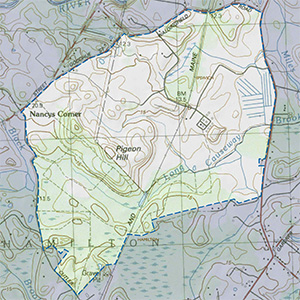Important Bird Area Sites in Massachusetts
Important Bird Area: Appleton Farm
Site Summary
Nominated By
Jim Berry
Size
953 acres
Towns and Counties
Hamilton and Ipswich; Essex County
Ownership
The Trustees of Reservations (TTOR)
Major Habitats
35% oak-conifer transitional forest, 41% cultural grassland (40% [16% of total] is wet meadow), 8% cultivated field, 13% palustrine wood swamp
Land Use
Nature and wildlife conservation/land trust, other recreation or tourism, agriculture/livestock, forestry (potential), undeveloped
Serious Threats
Invasive or non-native plants
Minor Threats
Cowbird parasitism, succession (controlled with grazing), overgrazing/overbrowsing (cattle, deer, etc.), disturbance to birds or habitat (agriculture)
IBA Criteria
- Category 2: Sites important for long-term research and/or monitoring projects that contribute substantially to ornithology, bird conservation, and/or education.
- Category 4: Sites containing assemblages of species characteristic of a representative, rare, threatened, or unique habitat within the state or region.
- Category 5: Sites regularly holding significant numbers of species of high conservation priority in Massachusetts.
Site Description
The Appleton family turned over Appleton Farms in its entirety to The Trustees of Reservations (TTOR) in 1998. Included in its 953 acres are about 500 acres of pastureland and 400 acres of woodland. It is the oldest farm in continuous operation in the US, having been established by the Appletons in 1638. Appletons managed the farm from then until 1998. The land has been used as pasturage and for cattle raising, with various crops being cultivated there over the years. The pastures are rolling hills with wet meadows in some areas. The forested parts are likewise rolling, the pine-oak uplands mixing with red-maple swamps. The site is nominated as an IBA not for the forested areas but because of the nesting grassland birds, namely Bobolinks and Eastern Meadowlarks. It is one of the best nesting sites in the state for those species.
Current Conservation Status
The Trustees of Reservations will maintain the farm in active agriculture. The goal for the farm, as stated in the Management Plan, is to provide opportunities for visitors to learn about and enjoy the property's historic, scenic, ecological, and agricultural features; to interpret the farm's agricultural activities and history for the public; and in so doing to reconnect people to the land, instill a sense of stewardship for the farm, and promote a conservation ethic for the land.
Also, TTOR is trying to manage for native species of vegetation, particularly grasses. Sheep have been used in winter to control exotics such as multiflora rose, which invades the pastures and would succeed grasses if permitted. Cowbird parasitism is probably a minor problem for the grassland birds that are the focus of conservation efforts. Agriculture poses some disturbance to nesting birds, but active operations (grazing and haying) are generally kept out of the fields used during the breeding season until nesting is completed.
Ornithological Significance
The primary importance is for nesting Bobolinks and Eastern Meadowlarks. The pastures also have potential for nesting Upland Sandpipers, Vesper Sparrows, and Grasshopper Sparrows. (Several pairs of Savannah Sparrows nested in 2001.) The conifer stands in the forested areas have potential for nesting Sharp-shinned Hawks. The barns have potential for nesting Barn Owls, and the farm supports 1 or 2 pairs of nesting American Kestrels. The pastures have secondary importance as a migration stopover; one significant species is included in the table below to show its value for migrants. Grassland habitat is becoming increasingly rare in Massachusetts, and its value to the first two species has already been established by point counts over the last 3 years. In addition, under TTOR's Management Plan for the property, about 300 of the 500 acres of grassland are being managed for "conservation agriculture," and 160 acres are managed specifically for nesting grassland birds. The staff has inventoried water resources, soils, vegetation, and wildlife on the entire property and will continue monitoring the major resources, including nesting grassland birds, by quantitative methods for years to come. The property thus fits category 4 for endangered habitat and category 5 for its long-term monitoring plans.
The Bobolink and Eastern Meadowlark data are from point counts conducted on the grassland portions of the farm in 1999, 2000, and 2001. The Common Snipe number was from a one-day fall count and is not surprising given the size of the habitat and the amount of it (about 40%) that is wet meadow. Counts were organized and run by Wayne Castonguay, former Regional Ecologist of TTOR and current Superintendent of Appleton Farms. These counts will be continued in years to come as pasturage and haying are managed in conjunction with grassland bird habitat.
Other Flora or Fauna of Significance
None known.
Data Sources
J. Berry, TTOR data.




